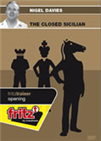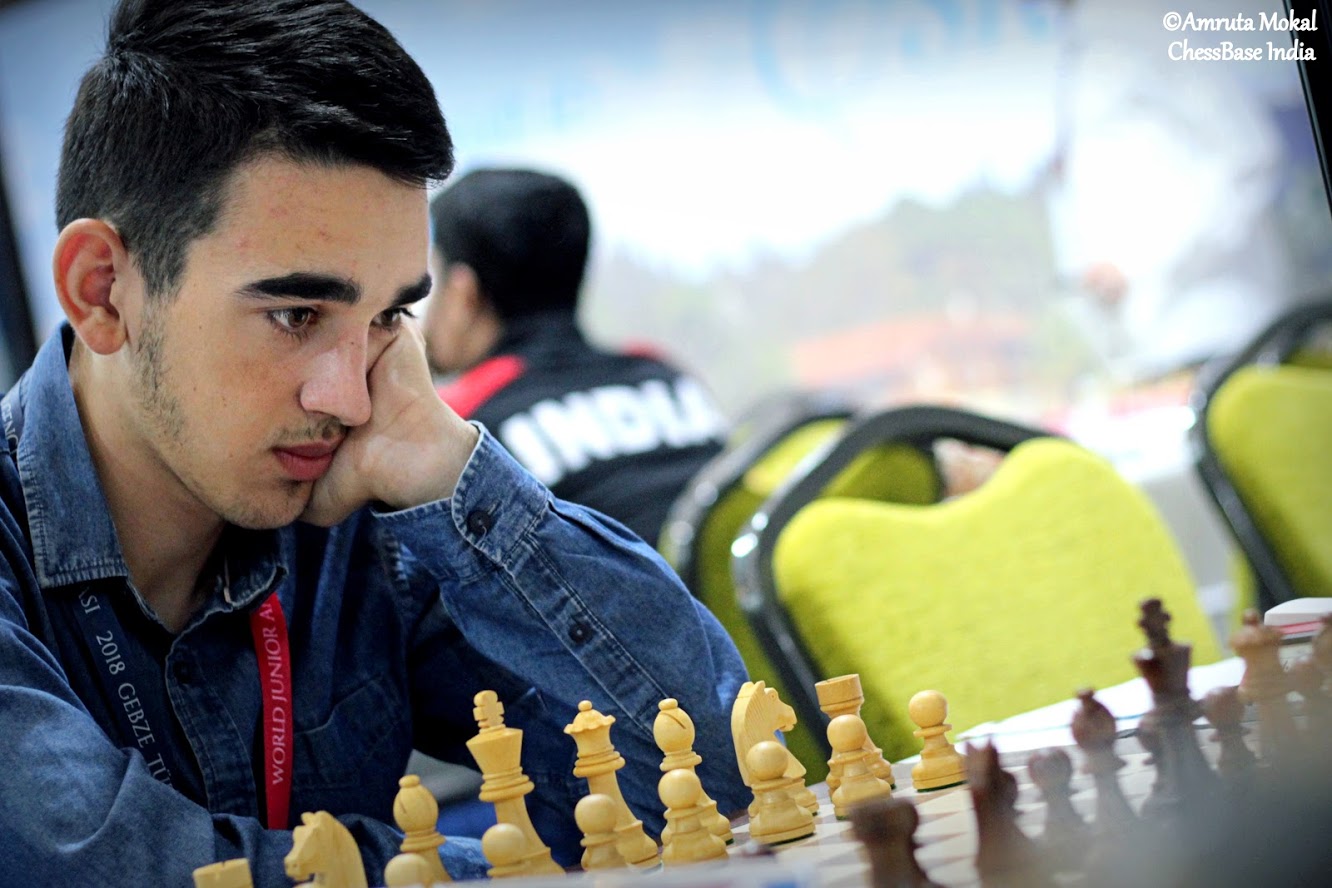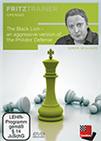Read Part I of the interview!
In part I of the interview with Aeroflot Open winner Kaido Kulaots we discussed his tournament until round 6. He was on 4½/6. Sasikiran Krishnan led the tournament by a full point. In spite of this, the tournament had gone like a dream for Kaido. He had scored three wins over super strong opponents Parham Maghsoodloo, Alireza Firouzja and Daniil Dubov. But it is one thing to start the tournament well, and quite another to finish it with the same momentum. The last three rounds were going to be extremely tough. At stake was not just the first prize of €18,000 but also the qualification spot to the super tournament — Dortmund 2019. In round 7 Kaido, faced the top seed of the event Wei Yi.

Wei Yi, the top seed of the Aeroflot Open 2019 was Kaido's seventh round opponent | Photo: David Llada
Sagar Shah (SS): After 4½/6, next up was Wei Yi. Tell us about the game.
KK: I replied to his 1.e4 with my customary move in this tournament — 1…c5. He chose the closed Sicilian. I was aware of the variation that Wei Yi chose (it had been practised by Rapport amongst others), but I had not really checked this line for a long time. It led me trying to be very smart and original right from the early stages. It backfired most horribly as White ended up getting about as much as one could ever dream from such an unpretentious line as the Closed Sicilian. I missed one little thing, then another and soon enough I was on the verge of getting steamrolled. But defensive resources in chess are notorious for being inexhaustible at times.
When Wei Yi entered my position with his rook on c6, he must have been so happy with his position and future prospects. But then I simply protected my d6 pawn with ♜ad8. OK, I self pin my f6 knight, but so what. I keep the material balance and plan to continue doing so for the time to come. On his next move Wei Yi spent incredible amount of time. On one hand it was a notoriously difficult choice between many good continuations, on the other — how to really break through Black's position that looks so shaky? His decision to give up his dark squared bishop was very committal, but the idea being understandable — he wanted to dominate me completely on light squares. Then the checkers started, just that white was playing on light and black on dark squares.
On the next move he had a choice to make, either allow e5-e4 (what nice memories from the 1st round!) or g6-g5. He played his bishop to e4 instantly and I made an absolutely essential push g6-g5. I was not then quite sure how should White be taking down this dark squared fortress. We then moved on to shuffling around phase (the most important event being the opening of h-file, which I, to be honest, thought to be more favourable for Black) and by time control I was pretty sure that I was outside of any danger. Furthermore, I started to envision scenarios, where my pieces are accessing the vicinity of his king. And just when I started getting too excited, he calmly and quickly demonstrated me that everything is still under control, by transferring his king to g2.
Steinitz would have been delighted, the king defends himself! And now, when my attacking ideas came to quick halt, a bit of panic mode kicked in upon seeing that he simply plans to hoover up my queenside infantry.
But then I came up with this b4-b3 push. It was a beautiful practical chance. Without even changing the objective evaluation of the position! It still remained within the equality, but the character of it changed considerably. True, White was now 1.5 pawns up, but instead of one open file, which was by now under the lock and key of white's monarch, Black could dream about using open files on the queenside too. It started to seem more probable to me that in one way or another white king would end up in some sort of trouble than White passers starting to present any real danger. And, like in my game against Maghsoodloo, that dark squared bishop was waiting to get released, to cause quite some destruction!
When he missed 61…♛d7 and was forced to play g3-g4, I could plant my rook on h4. From this moment on I understood that White's position was much harder to play. Most and foremost because of different level of king security and secondly because of different potential energy of bishops. Once the bishop was about to strike, he was forced to give up the exchange. Things were not completely clear cut yet, but he could not handle all the problems and once my king got into freedom as it is prescribed in endgame manuals, the fight came to its conclusion. I think I need to be very thankful to my good physical shape that enabled me often to come out on top from these long games.
 For players who lack either the time or inclination to study reams of opening theory the Closed Sicilian (1.e4 c5 2.Nc3 followed by 3.g3) is an excellent choice. The two great exponents of this method of play were World Champions Vassily Smyslov and Boris Spassky. These days it’s the top English Grandmasters Michael Adams and Nigel Short who are its leading exponents.
For players who lack either the time or inclination to study reams of opening theory the Closed Sicilian (1.e4 c5 2.Nc3 followed by 3.g3) is an excellent choice. The two great exponents of this method of play were World Champions Vassily Smyslov and Boris Spassky. These days it’s the top English Grandmasters Michael Adams and Nigel Short who are its leading exponents.SS: In the last round it was quite a dramatic finale. There were three leaders who were facing three different opponents. What was your approach to the game?
KK: In some interview it was written that I understood that I had to play for the win. In reality, I said that I was not completely sure for which result to play. I was fully aware that in case of ties I would have the best tie-break by far as I already had five blacks and secondly, my opponents average was huge. The only problem was that somebody could finish with more points. There were two such candidates. [One was] Sasikiran, who played the first half of the tournament just brilliantly — he got a second white in a row (after having white against me in previous round), which isn't always necessarily an advantage. His opponent was very solid, though. [The other was] GM Wang Hao, who came to the game with super solid strategy as well. It soon became clear that with very big probability this game would end in a draw.

Denis Khismatullin was Kulaots' last round opponent in a must-win scenario | Photo: Eteri Kublashvili
Right: Sasikiran had started the tournament well, but in the end had to settle for the third spot | Photo: David Llada
KK: And then there was young Armenian GM Martirosyan. He was black against his compatriot Tigran Petrosian, who had half a point less. I could not really assume that Petrosian would lead the battle as safely as his famous namesake normally used to half a century ago, so there was a potential for that position becoming messy and where there is a mess, anything is possible.

Haik Martirosyan beat Tigran Petrosian in the final round and tied for first. He finished second on tiebreaks | Photo: Amruta Mokal
But by the time when positions on important neighbouring boards started to clarify, it was already obvious to me that my opponent Denis Khismatullin had come to the game only with one goal — to give his absolute best and take every chance of clinching the win in the game and provided other circumstances, also the tournament! Besides the victory in our game he needed the first two boards to end in draws, which one would consider a rather probable thing to happen. So his fighting spirit was fully understandable and justified. Besides, not at all long ago, he used to be a 2700 player himself. To be honest, if he had chosen some more forced and concrete opening line, I would have, so to say, checked his documents and if everything had been in order then the game would probably have ended in splitting the point. He instead went for less forced, albeit more passive (initially!) position. Curiously, in the last round of Budapest Spring 2018, which was my previous major triumph with 2750+ performance, my opponent also chose this line. Probably I will need to have a better look at it in the future, just in case.
 Looking for an interesting, exciting, aggressive and flexible opening to play against 1 e4!? Then the Black Lion is just the opening for you! The Lion gets ready to roar after 1.e4 d6 2.d4 Nf6 3.Nc3 e5 4.Nf3 Nbd7 5.Bc4 Be7 6.0–0 c6 – and now Black wants to attack with an early ...g5. Grandmaster Simon Williams suggests a simple to learn, yet deadly system of development for Black. He explains the main ideas of this opening in an easy and entertaining manner, using examples from such maverick players as Baadur Jobava. In what other opening do you get a chance to attack White’s castled King with an early ...g5? Let the Lion roar and the fun commence!
Looking for an interesting, exciting, aggressive and flexible opening to play against 1 e4!? Then the Black Lion is just the opening for you! The Lion gets ready to roar after 1.e4 d6 2.d4 Nf6 3.Nc3 e5 4.Nf3 Nbd7 5.Bc4 Be7 6.0–0 c6 – and now Black wants to attack with an early ...g5. Grandmaster Simon Williams suggests a simple to learn, yet deadly system of development for Black. He explains the main ideas of this opening in an easy and entertaining manner, using examples from such maverick players as Baadur Jobava. In what other opening do you get a chance to attack White’s castled King with an early ...g5? Let the Lion roar and the fun commence!SS: The fireworks began in the middlegame. Tell us more about this critical phase of the game.
This 26…d5 exd5 and 27…♝c7 was an excellent clearance motif, setting up all sorts of things happening on White's back rank. Denis must have been well aware that in case he chooses a slower continuation, then White´s next moves will be ♔f1, ♘g1-f3. If White achieves this, he will feel himself very safe. And this, let's agree, is not that little at all in this kind of tournament situation. So in practical terms his choice was really unpleasant for me. I think that 28.a6 was one of my most important decision of the tournament.
I could have hung on to my extra pawn or even grabbed another one, but that would have been extremely dangerous and tough to navigate under time pressure. And indeed, when you insert grabbing the second pawn to the comp, it will (not immediately) show that White has excellent chances of ending up in all sorts of trouble. So my approach was to go with 28.a6, after calculating that the lines that indeed did happen in the game. I had checked that these lines at least do not lose for white. If it is a draw in some way, then so be it. But I did not see a forced one.
I know your computer gives 32…♜e8 (in the above position) and perpetual on f7 and h5 as the first line, but giving a check in time trouble is a natural instinct. Or maybe Denis was not too sure about 33.♕f4?, although those lines are completely insane (and drawn).
So after 28.a6 I had very clearly seen that after 32.dxc7 White is not losing this game. The fact that we would be playing for two results, suited me! This being said, I did have to evaluate the lines with the insertion of b7-b5 as well.
The queen ending — White is two pawns up (after the important little move ♕f5-e5) and for many it might have looked as a piece of cake, but in reality it is far from being as such.
First of all, by our century it is well-known that theoretically speaking h+g is under regular circumstances is not winning in queen ending as recently also my teammate Eduardas Rozentalis demonstrated in Bundesliga against Jonny Hector. And secondly, as everybody could relearn from Anish Giri's tweet, there was a recent game between Vidit Gujrathi and Erwin l'Ami, where this very 3 vs 1 occurred and that ended in a draw. And thirdly, I very well remembered a queen ending of myself from Estonian championship 22 years ago, when after good seven hours of play I was approaching the promotion of my passed extra pawn in queen ending and with it the victory over so far inconvenient opponent for me, Sergei Zjukin. Only to be mated by one long queen move. I really did not want to face anything similar again, so I forced myself to stay focused until the very last move.
SS: Would you rate this tournament victory as the biggest in your chess career?
KK: Aeroflot is certainly something very special, so I will put it to the first spot without any doubt.
SS:What does playing in the Dortmund super tournament mean to you? How will you prepare for the same?
KK: Dortmund will be a new experience for me, I do not really have experience of any Round Robin super tournaments. I will try to arrange the preparation as well as my intellectual and other capacities enable me.
SS: A lot of people have said that chess is a young man’s game, yet at the age of 43 you were able to show this performance! What would be your advice to players above 40 like you?
KK: In general we indeed see the youth making forceful move forwards, just look at the lineup here in Moscow. One day while walking a funny thought occurred to me — is there anybody at all here who was older than me?! And I could not immediately come up with any names! Only when looking around in the playing hall during the next round I noticed Belarusian GM Aleksandrov, whom I first saw playing in 1987 in my native town of Pärnu and whom I knew being older than me. But that was it, no other older players! There is a big probability that here in Moscow we had a future World Champion playing (or more than one) On the other had, compared to other sports, in chess there still is at least a theoretical chance for players in their forties (let's for now not talk about fifties and on) to achieve big results. The thing is that by 40 the vast majority of chess players have quit aiming for monstrous results like these or quit the game of chess altogether, which is of course fully understandable. Those who are still seeking to conquer the higher peaks should definitely pay very close attention to physical fitness, proper nutrition and an altogether healthy lifestyle. This all, of course, in addition to continuous hard chess work.

In chess, players above the age of 40 can only compete with youngsters if they are able to stay physically fit | Photo: Kaido Kulaots Facebook page
SS: Lastly, who are the people that you would like to thank for this victory?
KK: Definitely I would like to thank my parents and whole family for big support. My girlfriend (we are having a common home in Turku, Finland), for whom the long periods of me being away have certainly not been easy. Also, I would like to thank my first and also the last coach Arne Juurikas from the days in Pärnu, where I spent my youth. And I would like to thank everybody who have not stopped believing in me and have thus also reinforced this belief in myself!
Final standings (top 20)
| 1 |
62 |
GM |
Kulaots Kaido |
|
EST |
2542 |
7,0 |
5 |
2647 |
| 2 |
28 |
GM |
Martirosyan Haik M. |
|
ARM |
2616 |
7,0 |
4 |
2563 |
| 3 |
11 |
GM |
Sasikiran Krishnan |
|
IND |
2678 |
6,5 |
4 |
2607 |
| 4 |
3 |
GM |
Wang Hao |
|
CHN |
2714 |
6,0 |
5 |
2600 |
| 5 |
1 |
GM |
Wei Yi |
|
CHN |
2733 |
6,0 |
4 |
2589 |
| 6 |
30 |
GM |
Chigaev Maksim |
|
RUS |
2613 |
6,0 |
4 |
2586 |
| 7 |
7 |
GM |
Inarkiev Ernesto |
|
RUS |
2692 |
6,0 |
4 |
2580 |
| 8 |
21 |
GM |
Sarana Alexey |
|
RUS |
2630 |
6,0 |
4 |
2573 |
| 9 |
15 |
GM |
Anton Guijarro David |
|
ESP |
2642 |
6,0 |
4 |
2557 |
| 10 |
43 |
GM |
Tabatabaei M.Amin |
U18 |
IRI |
2590 |
5,5 |
5 |
2613 |
| 11 |
9 |
GM |
Korobov Anton |
|
UKR |
2687 |
5,5 |
5 |
2585 |
| 12 |
47 |
GM |
Vaibhav Suri |
|
IND |
2575 |
5,5 |
5 |
2577 |
| 13 |
13 |
GM |
Sjugirov Sanan |
|
RUS |
2663 |
5,5 |
5 |
2558 |
| 14 |
23 |
GM |
Paravyan David |
|
RUS |
2627 |
5,5 |
5 |
2536 |
| |
60 |
GM |
Hakobyan Aram |
U18 |
ARM |
2545 |
5,5 |
5 |
2536 |
| 16 |
25 |
GM |
Khismatullin Denis |
|
RUS |
2621 |
5,5 |
5 |
2526 |
| 17 |
35 |
GM |
Deac Bogdan-Daniel |
U18 |
ROU |
2603 |
5,5 |
4 |
2647 |
| 18 |
32 |
GM |
Lupulescu Constantin |
|
ROU |
2610 |
5,5 |
4 |
2640 |
| 19 |
61 |
IM |
Sychev Klementy |
|
RUS |
2545 |
5,5 |
4 |
2609 |
| 20 |
29 |
GM |
Zhou Jianchao |
|
CHN |
2615 |
5,5 |
4 |
2601 |
Kaido will make his maiden appearance at a super tournament — Dortmund — later this year!
Links


























